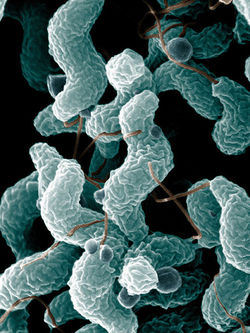Campylobacter species - Overview
| Campylobacter | |
|---|---|
| Phylum | Proteobacteria |
| Class | Epsilon Proteobacteria |
| Order | Campylobacterales |
| Family | Campylobacteraceae |
| Genus | Campylobacter |
Overview
Campylobacter live on the mucosa of the intestinal and genital tract and can be commensals or pathogens. The enteric species cause disease in humans and other species cause infertility and abortion in cattle and sheep. Campylobacteriosis is caused by Campylobacter organisms. C.jejuni and C. lari is excreted in the faeces of birds and pigs and can contaminate water and food supplies. C.fetus is restricted to the bovine prepucial mucosa. Captive reptiles may be the reservoir in cases of human infection.
Characteristics
The bacteria are curved, Gram negative rods with polar flagellum to aid motility. The daughter cells remain joined, giving a gull-wing or spiral appearance. They are microaerophilic and sensitive to drying. Campylobater species can be divided into; Thermophilic species, including C.jejuni and C. coli and Non-thermophilic species e.g. C.fetus. They can grow on enriched selective media e.g. Skirrow agar in 1-10% carbon dioxide and 5-10% oxygen tension. Many grow on MacConkey, however C.jejuni requires increased temperatures for growth.
C.fetus subspecies venerealis and subspecies C.fetus have small, round, smooth, translucent colonies. C.jejuni has small, flat, grey colonies with watery appearance.
Smears are stained with dilute carbol fuschin for 4 minutes.
Pathogenesis and pathogenicity
C. fetus subspecies fetus and subspecies venerealis possess a microcapsule (S layer) which resists phagocytosis and serum-mediated destruction and enhances survival in the genital tract. Antigens of the S layer undergo antigenic shifts in C. fetus subspecies venerealis, allowing persistence in the host. C.jejuni attaches and invades host enterocytes and produces enterotoxin-like substances. The Flagellae of C.jejuni are required for colonisation.
See here for a list of Campylobacter species
See Campylobacteriosis in dogs and cats and cattle.
| Campylobacter species - Overview Learning Resources | |
|---|---|
 Test your knowledge using flashcard type questions |
Campylobacter Flashcards |
| This article has been peer reviewed but is awaiting expert review. If you would like to help with this, please see more information about expert reviewing. |
Error in widget FBRecommend: unable to write file /var/www/wikivet.net/extensions/Widgets/compiled_templates/wrt6934b0ba8ff648_85691582 Error in widget google+: unable to write file /var/www/wikivet.net/extensions/Widgets/compiled_templates/wrt6934b0ba97efa7_61184881 Error in widget TwitterTweet: unable to write file /var/www/wikivet.net/extensions/Widgets/compiled_templates/wrt6934b0ba9be838_85035995
|
| WikiVet® Introduction - Help WikiVet - Report a Problem |
